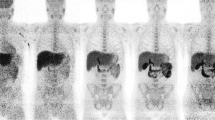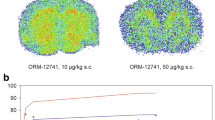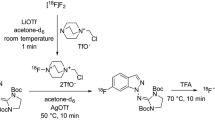Abstract.
Carbon-11 labelled RS-15385-197 and its ethylsulphonyl analogue, RS-79948-197, were evaluated in rats as potential radioligands to image central α2-adrenoceptors in vivo. The biodistributions of both compounds were comparable with that obtained in an earlier study using tritiated RS-79948-197 and were consistent with the known localisation of α2-adrenoceptors. The maximal signals (total to non-specific binding) were, however, reduced, in the order [11C]RS-79948-197 < [11C]RS-15385-197 < [3H]RS-79948-197, primarily due to the difference in radiolabel position (O-methyl for carbon-11 compared with S-ethyl for tritium). This resulted in the in-growth of radiolabelled metabolites in plasma, which, in turn, contributed to the non-specific component of brain radioactivity. Nonetheless, the signal ratio of ∼5 for a receptor-dense tissue compared with the receptor-sparse cerebellum, at 90–120 min after radioligand injection, encouraged the development of [O-methyl-11C]RS-15385-197 for human positron emission tomography (PET). Unfortunately, in two human PET scans (each of 90 min), brain extraction of the radioligand was minimal, with volumes of distribution more than an order of magnitude lower than that measured in rats. Following intravenous injection, radioactivity was retained in plasma and metabolism of the radiolabelled compound was very low. Retrospective measurements of in vitro plasma protein binding and in vivo brain uptake index (BUI) in rats demonstrated a higher protein binding of the radioligand in human compared with rat plasma and a lower BUI in the presence of human plasma. It is feasible that a higher affinity of RS-15385-197 for human plasma protein compared with receptor limited the transport of the radioligand. Although one of the PET scans showed a slight heterogeneity in biodistribution of radioactivity which was consistent with the known localisation of α2-adrenoceptors in human brain, it was concluded that [O-methyl-11C]RS-15385-197 showed little promise for routine quantification of α2-adrenoceptors in man.
Similar content being viewed by others
Author information
Authors and Affiliations
Additional information
Received 26 October 1999 and in revised form 21 January 2000
Rights and permissions
About this article
Cite this article
Hume, S., Hirani, E., Opacka-Juffry, J. et al. Evaluation of [O-methyl-11C]RS-15385-197 as a positron emission tomography radioligand for central α2-adrenoceptors. Eur J Nucl Med 27, 475–484 (2000). https://doi.org/10.1007/s002590050531
Issue Date:
DOI: https://doi.org/10.1007/s002590050531




